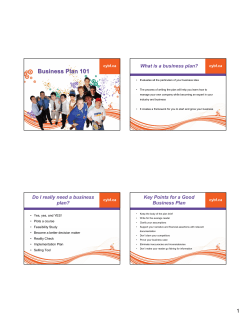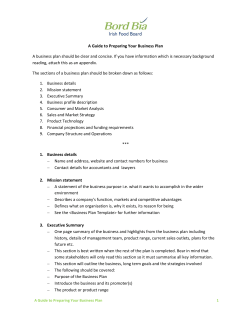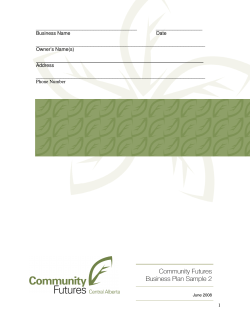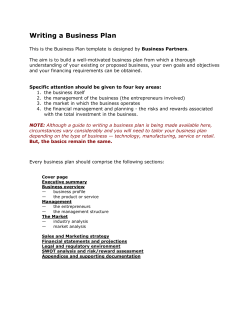
Business Plan Development
Business Plan Development Developing a comprehensive business plan is one of the services that KCARD offers to its clients. A business plan is a company’s roadmap for success. An updated, comprehensive business plan increases the likelihood of success for new and existing businesses. “Failing to plan is planning to fail.” The business plan answers the key questions about the business: who, what, where, when, why, and how. For a developing business, the business plan begins the process of making an idea materialize into reality and determining whether or not an idea should become reality. The business plan establishes goals and benchmarks for the business. A comprehensive business plan makes it easier for a business to receive external support, especially in terms of financing from potential investors, lenders, and grant sources. Finally, and possible most importantly, going through the process of planning is very valuable because it forces the business owners and/or managers to think through every detail of the business. “In preparing for battle, I have always found that plans are useless, but planning is indispensable.” Dwight D. Eisenhower A comprehensive business plan should cover the following: Description of Business (products, locations, ownership, structure, history) Marketing Plan (positioning, products, pricing, target markets, distribution, advertising, sales force) Management Plan (organizational structure, roles for management team, hiring & training personnel) Financial Management Plan (accounting system, inventory control, loans) Financial Projections (3-year pro forma cash flow and income statement projections) KCARD staff are capable of facilitating the process of developing or updating a business plan for new and existing businesses. In this process, KCARD takes a very hands-on approach, but KCARD only plays the role of facilitator. KCARD will not just produce a business plan for a company without any input from the company’s owners or managers. In assisting with the development a business plan, KCARD will: Facilitate a minimum of 3 working meeting with members (3-5 members is the optimal number involved) of the management team. Each of these meetings last around 2-3 hours, move very quickly, and are relatively intense. Two to three KCARD staff members will be involved in these meetings with one staff person taking notes and one staff person running the meeting; Ask members of the management team questions related to the basic components of business plan, and assigning homework to participating management team members on various aspects of the business; Develop financial projections based upon agreed upon assumptions by members of the management team; Write draft of the plan from the input of the participating management team members, and producing final copy after management members review and edit draft of plan; Give oral report of the completed business plan; Complete the business plan in 4-6 weeks—the speed in which completed is determined by how quickly management team members can meet and work through the key questions. At the end of this process, KCARD is very confident that a business will not only a very comprehensive business plan, but a plan that is truly theirs. KCARD believes that all businesses benefit from going through this process because of the value of just going through the planning process that is required to develop a comprehensive business plan. Business Plans October 2000 By: Timothy A. Woods and Heath Hoagland University of Kentucky Department of Agricultural Economics 400 Charles E. Barnhart Bldg. Lexington, KY 40546-0276 Phone: 859-257-5762 Fax: 859-323-1913 http://www.uky.edu/Ag/AgEcon/ Business Plans What goes in a business plan? The body of the business plan can be divided into four distinct sections: I. The description of the business. II. The marketing plan III. The management plan IV. The financial management plan1 Additional items to address in a business plan will include a production plan and long-term plan. These items are not directly addressed in this paper. I. Description of the Business. may influence the viability of alternative supplier positions? What competitive advantage does the association have in the respective market? Provide a detailed description of your business. Ask questions such as “What business am I in?”. When answering this question include your products, market and services as well as a thorough description of what makes your business unique. As the business plan develops, initial questions may be modified. Note the description of the business corresponds closely with the feasibility study questions proposed on the previous sheet. Product line What products will be emphasized in each target market? How are they chosen? How are new products introduced? Will there be any attempt to differentiate products? Price What product price will be necessary to make the targeted market viable? What are the break-even costs? What have prices been historically for similar products in the market? How will prices be determined? Who will determine it? II The Marketing Plan The marketing plan, or sometimes referred to as the “game plan” is more detailed than the questions asked in a feasibility study. The marketing plan actually outlines the activities to undergo in day-today operations, and the overall long run marketing projections. Distribution Will distribution involve largely local channels or will there be significant inter-state trade? Is a PACA license necessary? How might growers efficiently manage/coordinate their deliveries with outbound logistics? Might this be different depending on the target market? What specific outlets, businesses, or customers will be targeted within targeted market channel? Are there specific distribution and packaging needs for these customers? Positioning What are the intended or desired goals for the association with respect to how they want to be regarded as a supplier to the targeted market? Primary in-season supplier? Gap or short order supplier? Steady but secondary presence? What competitive factors outside the association 1 Information included in this guide comes from the Small Business Administration (SBA) website, and the NXLevel Guide for Entrepreneurs . 1 Sales force Who will handle the sales activities? How will contacts be made and maintained? Are there guidelines that need to be developed for sales staff? Special training? What sales activities are standard (required?) For the targeted market? resources would be necessary to carry on needed market research? What industry communications monitor the relevant trends for the targeted market? What are the costs and benefits of the market research? The 11 components above are guidelines to follow. The components are very important and any entity will vary from the next in answering the components. The association can benefit from having basic information and alternatives generated from this marketing plan. Sales promotion Are special sales promotions beneficial to the development of a presence in the marketing channel? What are some cost-effective ways of starting? What are industry conventions for sales promotions? Trade shows? Industry associations? III. The Management Plan Managing a business requires dedication, persistence, the ability to make decisions, and the ability to manage both employees and finances. Your management plan, along with your marketing and financial management plans, sets the foundation for and facilitates the success of your business. Employees are critical resources and will play an important role in the overall operation of your business. Knowing how to manage and treat employees is critical. The management plan should answer questions regarding: Advertising What advertising (if any) might be justified for the target market? What are effective media? Should there be a portion of the budget allocated to advertising? Should a professional agency be employed or can the association manage it? Are there any outside resources to help develop advertising to targeted customers? Service Are unique services expected for the market being considered? What are the costs and benefits to providing these services? What service might be necessary for the association to achieve the desired position in the market? Who provides the services? C How does bac k g r o u n d s / b u s i n e s s experience help in the business? C Who will be on the management team? C What are the strengths and weaknesses of the management team? Research and development What activities can help the association monitor new industry tools and technology that may help the association improve its functioning or products? Is R&D likely to be important for the target market? Has there been considerable innovation within the segment recently? How might R&D needs be identified and communicated to organizations positioned to help the association with this task? C What are the duties of the management team? C What are the plans for hiring and training personnel? C What salaries, benefits, holidays will you offer? Marketing research What trends may be important to watch in relation to the targeted market segment? What vacations, C What benefits, if any, can you afford at this point? 2 IV. The Financial Management Plan The financial section of the business plan should include any loan applications, capital equipment and supply list, balance sheet, breakeven analysis, proforma income projections, and pro-forma cash flow. The income statement and cash flow projections should include a three-year summary, detail by month for the first year, and detail by quarter for the second and third years. Sound financial management is one of the best ways for your business to remain profitable and solvent. How well the finances are managed is critical to every successful business venture. Polices will need to be implemented that will lead to and ensure that you will meet your financial obligations. The feasibility study answers questions regarding the start-up budget. This section deals more with the operating budgets. The following are ideas to start with in the budgeting process: • • • • • • • • • • • • • • • • • Accounting and inventory systems should also be addressed in this section of the business plan. Answer questions such as: personnel insurance rent depreciation loan payments advertising/promotions legal/accounting miscellaneous expenses supplies outside services (contracting a hauling company) payroll expenses salaries/wages utilities dues/subscriptions/fees taxes repairs/maintenance growth expenses • What type of accounting system will the business use? • What will the sales goal and net income goals for the coming year be? • What financial projections will be needed to include in the business plan? • What kind of inventory control system will be used? Prepared by Tim Woods and Heath Hoagland, Department of Agricultural Economics at the University of Kentucky. Revised: October 2000 3
© Copyright 2025





















